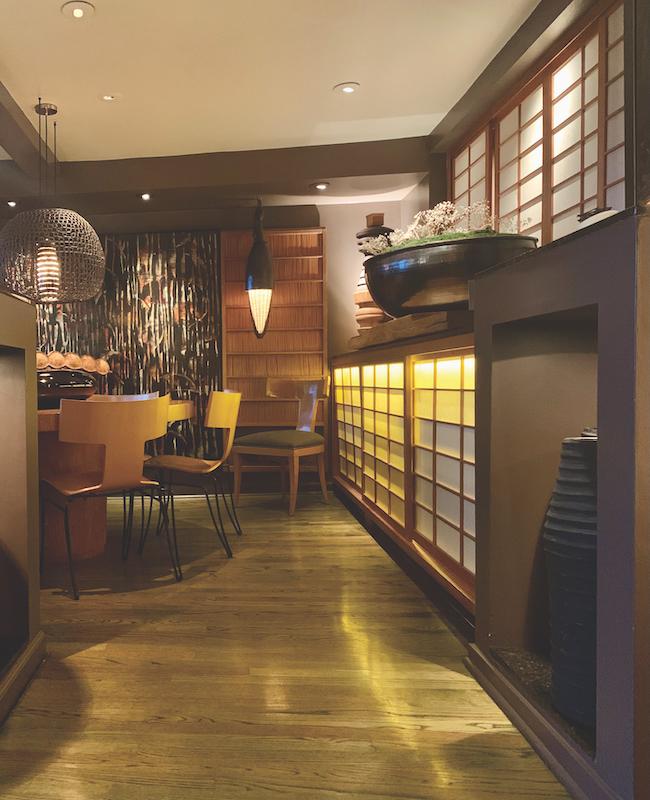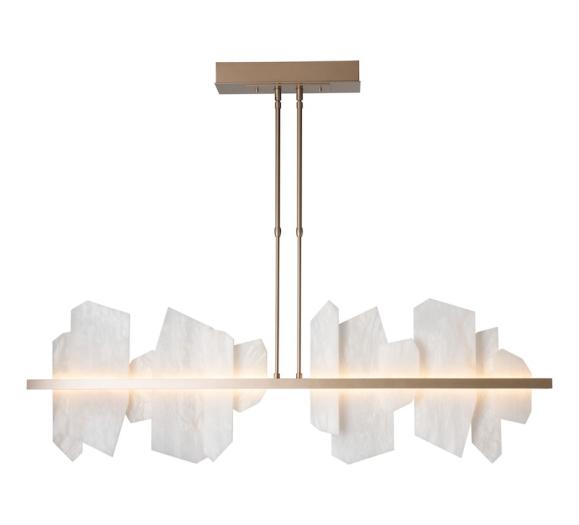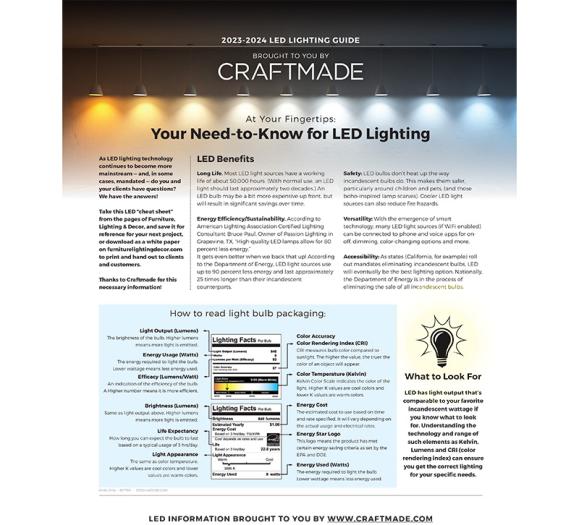When LEDs were first introduced, it was hard for us to part with our old friends incandescent and halogen lamps, and the luminaires made for them. It seemed like nothing could ever replace the warm glow, beautiful color rendering, and tight beam patterns of bulbs like the MR16 and PAR lamps. Now you can easily get LED MR16s and PARs in those warm colors we are used to enjoying.
Incandescent light sources are unacceptably inefficient – 95 percent of the output of a typical incandescent light bulb is in the non-visible infrared spectrum, which is to say, heat. Compact fluorescents (CFLs) are considerably more efficient than incandescents, but never quite made it into widespread residential use, mostly for their poor quality of light.
LEDs were originally developed to be much more efficient, a crucial need today, and they succeeded. Unfortunately, as with any new technology, early versions of LEDs were inadequate in many ways — especially color rendering — and much product was released on the market that was not quite suitable for home use. Many people shy away from LEDs because of these earlier versions. But these growing pains subsided gradually, and subsequent generations of LED lighting products eventually emerged that are truly better than incandescents in every significant way: efficiency, longevity, color rendering, distribution, flexibility and thermal performance.
It’s natural for us to compare LEDs to incandescents and halogens (a type of incandescent with a small amount of halogen gas in the bulb), since the hot lightbulbs we grew up with had been the dominant lighting technology for more than a century until LEDs evolved. While much of the effort to ensure adoption of LEDs has focused on making them as much like incandescents as possible, LEDs are different, and to work with them in residential lighting, you need to understand the differences between the two technologies, as well as the similarities.
Energy Efficiency
On average, LEDs use only 20 percent of the energy of incandescent lamps, which still make up the majority of installed residential light sources. One key difference with LEDs is that we measure their energy use by lumens per Watt (or lm/W) rather than Watts only. This is the “miles per gallon” measurement for lighting and is an improvement over watts only because it focuses on the output (what we’re getting for the energy used) rather than the input only — you would never refer to a car as a “25 gallon vehicle.” It’s also different because the efficiency of incandescents never varied too much, so our idea of brightness used to be, and in many cases still is gauged by Watts.
Not so with LEDS — the measure of brightness is lumens — you can find this information on the package. Typical lumens per Watt in commercially available LEDs today ranges between 80 and 200. Some states have established minimum efficiency requirements for light sources: California’s Title 20 for instance requires a minimum 80 lm/W. We feel that LEDs on the market now are sufficiently efficient, and while efficiency is and will always be important, we no longer need to sacrifice light quality for efficiency.
Form
It’s important to remember that LEDs are not actually “bulbs” in the sense that incandescent light sources are. They make light in a different way, as explained below, but only take on the form of incandescent bulbs to fit into luminaires designed for incandescents, not because the form is required for LEDs to work properly. This makes LEDs more comprehensible and adaptable, as they can be used in older luminaires. Then again, many LED light sources don’t need to use older luminiares, as they’re thinner, lighter, cooler, smaller and more powerful. Because of the pace of change, most lighting equipment designers haven’t begun to explore the full possibilities of new forms for LEDs. We’re still in a transition period between the old technology and the new, and probably will be for many years.
Longevity & Maintenance
LEDs last much longer than incandescent and halogen light sources and can save time and money in replacement and maintenance costs. LEDs fail by gradually losing their light output — lumen maintenance. Don’t trust lifetime claims over
60K hours.
Flexibility & Size
High output LEDs can be tiny — a fraction of the size of equivalent incandescents — and can fit anywhere. LED linear lights for instance, are incredibly flexible and can provide illumination in many places that were previously difficult or impossible to light.
Thermal Performance
LEDs are generally considerably cooler than incandescent lights but still generate heat. LEDS are also much more sensitive to thermal conditions — if you are replacing halogen lamps with LEDs in enclosed fixtures, check specifications on box or cutsheets to make sure the product is rated for enclosed fixtures.
Color Rendering
The best LEDs on the market provide color rendering equal to or better than halogen, but in a different way. As we look more closely at color rendering, even incandescent sources, long considered the gold standard, aren’t perfect. The metric commonly used for measuring color rendering, CRI, is far from perfect, as it’s possible to find light sources with even a high CRI of over 90 with poor color rendering. Color rendering is a complex phenomenon, and probably the hardest to get used to with LEDs — the
way they produce light and render color is fundamentally different than previous light sources, but at their best they are better than incandescent.
Color Temperature and Tunable Color
It’s possible to create LEDs with any conceivable color temperature; the range is unlimited. For residential lighting though, we need a relatively narrow range, from 2200K at the lowest to 4000K at the coolest.
One aspect of LEDs is completely new and different – color tuning. In addition to dimming, LEDS can change color temperatures. This has never been possible before outside of theatre and photography lighting. We are simply not quite used to this yet, as all previous light sources had fixed color temperatures. But now that we have it, we’re really making the best of it in many situations, practical or otherwise. For instance, previewing our clothing choices in our closet is a LED warmer in CCT when dimmed. Tunable white produces you a range of colors typically between a cool color temperature such as 4000K and a warm one such as 2400K. Some are available that go as high as 5000K and as low as 2150K. These are very useful in that closet or an open-plan layout where the kitchen is seen from the living and dining areas. You can use cooler light in the kitchen for doing food prep, then change to warmer light for eating or entertaining. Full color tunable light sources and luminaires can produce thousands of colors, including rich warm whites, peachy pink or, cornflower blue. Generally, this capability is used for special events like parties, but since it’s so new, and there are many lighting products on the market that allow full color tuning. People are experimenting and having fun. If you prefer a cornflower blue living room when you listen to Lizzo, you have my full permission to indulge!
Dimming and Warm Dimming
This is one area where LEDs are very different from incandescents. Because incandescents work on the simple principle of electric resistance, all of them can dim when controlled by sockets that can dim, and all of them will become warmer in color temperature when dimmed. LEDs don’t inherently operate this way because of how they’re controlled – they need specific power supplies or drivers. Not every LED light source can dim, and most are not yet “warm dim” capable. And most lighting designers have found that LEDs dimmed down significantly without warm dim capability look washed out. Although warm dim capability has only been introduced in the past five years or so, it’s already very good and widely available. Dimming controls are only useful in rooms in the home where you need to change light levels frequently, but that covers many room types, so for residential use, you will probably want LEDs that are warm
dim capable.
Distribution
To design effectively with LEDs, it’s important to understand the fundamentally different way in which they distribute light. Incandescent (and fluorescent) light sources are fundamentally omnidirectional — light from them goes in all directions and must be controlled and directed through often elaborate systems of optics (lenses) and shading devices. This means that even at very low output levels, they require shading and blocking to control the direction of light and mitigate glare, as even a candle in a dark room produces glare and often must be shaded to be used
more effectively.







